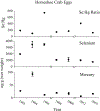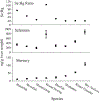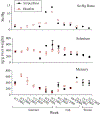Biomonitoring selenium, mercury, and selenium:mercury molar ratios in selected species in Northeastern US estuaries: risk to biota and humans
- PMID: 33471308
- PMCID: PMC9624179
- DOI: 10.1007/s11356-020-12175-z
Biomonitoring selenium, mercury, and selenium:mercury molar ratios in selected species in Northeastern US estuaries: risk to biota and humans
Abstract
The mutual mitigation of selenium and mercury toxicity is particularly interesting, especially for humans. Mercury is widely recognized as a pantoxic element; all forms are toxic to all organisms. Less well known is that selenium in excess is toxic as well. The high affinity between these elements influences their bioavailability and toxicity. In this paper, we use selected species from Barnegat and Delaware Bays in New Jersey to examine variations in levels of selenium and mercury, and selenium:mercury molar ratios between and within species. We report on species ranging from horseshoe crab eggs (Limulus polyphemus), a keystone species of the food chain, to several fish species, to fish-eating birds. Sampling began in the 1970s for some species and in the 1990s for others. We found no clear time trends in mercury levels in horseshoe crab eggs, but selenium levels declined at first, then remained steady after the mid1990s. Concentrations of mercury and selenium in blood of migrant shorebirds directly reflected levels in horseshoe crab eggs (their food at stopover). Levels of mercury in eggs of common terns (Sterna hirundo) varied over time, and may have declined slightly since the mid2000s; selenium levels also varied temporally, and declined somewhat. There were variations in mercury and selenium levels in commercial, recreational, and subsistence fish as a function of species, season, and size (a surrogate for age). Selenium:mercury molar ratios also varied as a function of species, year, season, and size in fish. While mercury levels increased with size within individual fish species, selenium levels remained the same or declined. Thus selenium:mercury molar ratios declined with size in fish, reducing the potential of selenium to ameliorate mercury toxicity in consumers. Mercury levels in fish examined were higher in early summer and late fall, and lower in the summer, while selenium stayed relatively similar; thus selenium:mercury molar ratios were lower in early summer and late fall than in midsummer. We discuss the importance of temporal trends in biomonitoring projects, variations in levels of mercury, selenium, and the molar ratios as a function of several variables, and the influence of these on risks to predators and humans eating the fish, and the eggs of gulls, terns. Our data suggests that variability limits the utility of the selenium:mercury molar ratio for fish consumption advisories and for risk management.
Keywords: Birds; Fish; Fish consumption; Horseshoe crabs; Humans; Mercury; Selenium; Selenium:mercury molar ratio.
Conflict of interest statement
Figures








References
-
- Abbasi NA, Jaspers VLBJ, Chaudhry MJI, Ali S, Malik RN (2015) Influence of taxa, trophic level, and location on bioaccumulation of toxic metals in bird’s feathers: a preliminary biomonitoring study using multiple bird species from Pakistan. Chemosph 120:527–537 - PubMed
-
- Abdullah M, Fasola M, Muhammad A, Malik SA, Bostan N, Bokhari H, Kamran MA, Shafqat MN, Alamdar A, Khan M, Ali N, Musstjab SA, Eqani AS (2015) Avian feathers as a non-destructive bio-monitoring tool of trace metals signatures: a case study from severely contaminated areas. Chemosph 119:553–361 - PubMed
-
- Able KW Fahay MP (2014) The first year in the life of estuarine fishes in the Middle Atlantic Bight Rutgers, Univ Press: New Brunswick, NJ
-
- Ackerman JT, Eagles-Smeith CA, Herzog MP, Hartman CA (2016) Maternal transfer of contaminants in birds: mercury and selenium concentrations in parents and their eggs. Environ Poll 210:145–154 - PubMed
-
- Agency for Toxic Substances and Disease Registry (ATSDR)(1996) Toxicological profile for selenium Agency for Toxic Substances and Disease Registry, US Public Health Service. Atlanta, Georgia
MeSH terms
Substances
Grants and funding
LinkOut - more resources
Full Text Sources
Other Literature Sources
Medical

